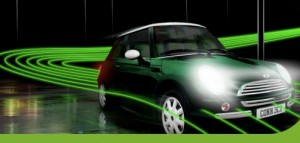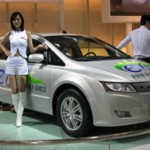GE to Place Order for `Tens of Thousands’ of Electric Vehicles
 By Rachel Layne and Alan Ohnsman Bloomberg – Oct 29, 2010
By Rachel Layne and Alan Ohnsman Bloomberg – Oct 29, 2010
General Electric Co. may jump-start the electric-vehicle industry with an order that Chief Executive Officer Jeffrey Immelt said will be the largest in history. GE, whose power-generation equipment provides a third of the world’s electricity, will order “tens of thousands” of the vehicles in about a week, Immelt said yesterday in a speech in London, without giving a total or identifying a manufacturer.
“This is a huge step up,” said Brett Smith, a vehicle technology analyst at the Center for Automotive Research in Ann Arbor, Michigan. “It’s the biggest order to date I’m aware of, by a lot.”
Expanding the world’s fleet of electric vehicles would bolster GE as it expands so-called clean-energy technology such as car chargers, solar panels and wind turbines. For every dollar of electric-vehicle sales, GE estimates it may get 10 cents in revenue, said Gary Sheffer, a spokesman. Immelt said half of GE’s sales force of about 45,000 will drive electric vehicles. The Fairfield, Connecticut-based company also has a vehicle-leasing division through its GE Capital finance unit. Financial terms and other details about the order aren’t yet being disclosed, GE said.
GE is investing $10 billion over the next five years in clean energy across its business lines, including power- transmission software and so-called smart-grid technologies. Its products include lithium-ion batteries for cars and trucks via a venture with A123 Systems Inc. and sodium-based batteries for use in large vehicles such as locomotives.
Creating Jobs
That spending creates jobs, Immelt told executives at an event sponsored by the University of Cambridge’s Programme for Sustainability Leadership. “GE has been one of the biggest players in this game and certainly has a lot to gain from the electric vehicle,” Smith said. “They’ve really truly tried to push this hard to get things going, and it seems to be a core corporate value.”
GE fell 6 cents to $16.02 at 4:02 p.m. in New York Stock Exchange composite trading. Shares of A123 climbed 5 cents to $9.72 on the Nasdaq Stock Market. An order the size of GE’s probably would come from several vehicle makers, Smith said. Automakers preparing to sell vehicles powered solely by batteries in the next 18 months include Nissan Motor Co., which starts delivering Leaf hatchbacks late this year; Ford Motor Co., readying electric versions of its Transit Connect delivery van and Focus compact car; and Toyota Motor Corp., which will sell a rechargeable RAV4 sport-utility vehicle.
Global Outlook
General Motors Co. begins delivering plug-in Volt hybrids this year, and Honda Motor Co., Chrysler LLC, Bayerische Motoren Werke AG and other large brands are preparing battery vehicles due by 2012. Combined deliveries of hybrids, such as Toyota’s Prius, and battery-powered cars may reach 5.2 million by 2020, according to an Oct. 27 forecast by J.D. Power & Associates. That would be about 7.3 percent of the projected global vehicle market. Immelt used his remarks in London to renew his call for increased private spending on renewable-energy investments. “Now is exactly the time, because it’s less popular, where we have to invest more,” Immelt said. “We have to do it more courageously. And we’re going to have to go forward for a while without government at our backs.”
GE Energy Infrastructure is the company’s biggest industrial unit, accounting for $37 billion of the parent company’s $157 billion in revenue last year. GE is also the world’s largest maker of locomotives, jet engines, medical- imaging equipment and related information technology systems. GE is the largest shareholder for Watertown, Massachusetts- based A123, which has signed agreements with Navistar International Corp. and Fisker Automotive Inc. to supply advanced batteries for their vehicles.
What Is An Electric Vehicle Conversion Specialist
 By: Ezra Drissman Electric vehicle conversion refers to the modification of a conventional internal combustion engine or the ICR driven vehicle to one that is battery electric propulsion, thus creating a battery electric vehicle. The career outlook for an Electric Vehicle Conversion Specialist is good. They make on average $39-$59 thousand a year. Electric vehicles are quickly becoming a mainstay in the auto arena. Many major automobile manufacturers in the US have started performing ICE conversions, but due to lack of consumer demand, the programs had been terminated. However, a few re-builders specializing in electric car conversion have started offering new or remanufactured conversion to satisfy the limited demand. One major reason for the rather low demand is the high price of completed vehicles, which can double the price of a comparable ICE vehicle.
By: Ezra Drissman Electric vehicle conversion refers to the modification of a conventional internal combustion engine or the ICR driven vehicle to one that is battery electric propulsion, thus creating a battery electric vehicle. The career outlook for an Electric Vehicle Conversion Specialist is good. They make on average $39-$59 thousand a year. Electric vehicles are quickly becoming a mainstay in the auto arena. Many major automobile manufacturers in the US have started performing ICE conversions, but due to lack of consumer demand, the programs had been terminated. However, a few re-builders specializing in electric car conversion have started offering new or remanufactured conversion to satisfy the limited demand. One major reason for the rather low demand is the high price of completed vehicles, which can double the price of a comparable ICE vehicle.
Why It’s Green
People who have owned and used electric vehicles points out that the ranges of these cars are adequate, and that it is more convenient to simply plug the car for charging rather than driving to get some gas. Aside from these, electric vehicles are also quiet if not totally silent and they are non-polluting because they use renewable energy rather than gas, which produces air pollutants.
Professional and Personal Qualities
Generally, people without experience or modest knowledge in mechanics and electrical devices should not attempt to maintain or operate a ‘home made’ electric vehicle. A career as Electric Vehicle Conversion Specialist is hard to come by in most states due to the lack of demand for electric vehicles. But in some places, and where companies manufacture electric vehicles, an electric car conversion specialist may be highly demanded.
Skills and Trainings
If you are planning to become an electric vehicle conversion specialist, you need a wide range of skills to be able to perform your duties. For instance, you’d need to have knowledge on automobile surveying and be able to identify problems in potential conversion vehicles. Such skill will be required to identify and purchase a good used ICE vehicle and will come handy especially when the conversion is done by another builder.
Aside from that, basic mechanics knowledge is also required as a builder should be able to manufacture small brackets for mounting sensors, switches and relays. Some other required skills and training for would-be electric car conversion specialists should include machine shop skills, welding, automotive mechanics, basic electric skills, as well as basic electronic skills.
Purdue student gets attention with solar motorcycle
Tony Coiro had never so much as ridden a motorcycle when he decided to re-engineer one.
Coiro, a sophomore at Purdue University, bought a 1978 Suzuki motorcycle on Craigslist.org and spent about six months installing solar panels on it that he bought on Ebay.com. The photovoltaic panels and all the other necessary parts and tools ran him about $2,500, he said. He’s received a preliminary patent for the finished product. He was inspired to start the project when he learned about how inefficient gas-burning internal combustion engines are. “I just thought, ‘there has to be a better way,’” the 19-year-old said in a phone interview. He knew how to do the welding and technical work. He could even model what he wanted to do on the computer beforehand. But he’d never tackled a project quite like this one before.
He didn’t do it as part of a class or assignment, and he didn’t enlist help from friends or professors, Coiro said.“It was just kind of a solo project,” he said. “I’m a physics major, so, you know, I’m going to be super analytical.”Since building the all-electric motorcycle, Coiro as teamed up with three classmates to form the Purdue Electric Vehicles Club.
“We were up late last night reading the University club guidelines on accepting funding,” he said. Now that the team has received national and international recognition, Coiro is hoping some grant funding for bigger projects might come their way. That’s one thing he admits he’s at a loss on—where to look for and how to apply for grants. The solar-charged lead acid batteries powering his Suzuki can carry him at a top speed of 45 miles per hour for a distance of 25 miles. But he has already done the preliminary design work for a solar-powered motorcycle that would top out at 100 miles per hour. It’s a bit speedy for a guy who’s only just learned to ride a motorcycle, but then his middle name is Danger. Or at least that’s what the international and national media believes. “It might be,” he said. “Or it might be Frank, and I might have gotten a bit carried away.” Pictured: Coiro with his solar motorcycle. Photo taken by Andrew Hancock for Purdue News Service.
Hertz Global to rent Electric Vehicles
 NEW YORK, NY – The Hertz Corporation announced today a Commitment to Action at the 2010 Annual Meeting of the Clinton Global Initiative (CGI) to bring the next generation of electric vehicles to the general public through its car rental and car sharing operations. As the world’s largest general-use airport car-rental brand, Hertz is uniquely positioned to introduce multiple groups of consumers — urban drivers, university students, travelers and corporations — to all-electric and plug-in hybrid vehicles. Hertz’s leadership in this initiative will catalyze other partners and cities to provide additional infrastructure for mass scaling of electric mobility.
NEW YORK, NY – The Hertz Corporation announced today a Commitment to Action at the 2010 Annual Meeting of the Clinton Global Initiative (CGI) to bring the next generation of electric vehicles to the general public through its car rental and car sharing operations. As the world’s largest general-use airport car-rental brand, Hertz is uniquely positioned to introduce multiple groups of consumers — urban drivers, university students, travelers and corporations — to all-electric and plug-in hybrid vehicles. Hertz’s leadership in this initiative will catalyze other partners and cities to provide additional infrastructure for mass scaling of electric mobility.
Hertz and its partners are planning to roll out the EV rental program starting this autumn with full-scale deployment in both the U.S. and other countries beginning in 2011. Hertz Global EV will be the first to provide a range of all-electric vehicles (EV) and plug-in hybrid electric vehicles (PHEV) and charging stations on a rental and car-sharing basis at this scale. “Our Hertz Global EV program will galvanize support for building out the infrastructure platform necessary to make electric vehicle travel an everyday reality,” said Mark P. Frissora, Hertz’s Chairman and Chief Executive Officer. “With our rental and car sharing expertise, industry relationships and global footprint, we are in an ideal position to lead this new frontier in transportation. This is the game-changer for electric mobility.”
Is There an Electric Car in Your Future?
 by Tony Sagami on September 15, 2010 In 2009, the world bought 61 million cars and almost all of them were powered by internal combustion, gasoline engines. That’s going to change in a big way.
by Tony Sagami on September 15, 2010 In 2009, the world bought 61 million cars and almost all of them were powered by internal combustion, gasoline engines. That’s going to change in a big way.
J.D. Power predicts that the world will buy 2 million electric vehicles by 2020. The researchers at HSBC are shooting much higher and expect the world to buy 9 million EVs (electric vehicles). When it comes to hybrid and electric cars, the Asians are rapidly becoming the global leaders in technology and sales. Korean auto giant Hyundai unveiled its first all-electric car last week, the BlueOn, which combines an efficient electric motor with the newest generation of lithium-ion polymer battery technology. The BlueOn can reach speeds as high as 81 miles per hour and can travel up to 80 miles. The car has two charging docks: One for household 220-volt outlets and a 380-volt industrial-strength power for quick recharging. The household plug takes six hours to fully charge, while the industrial charge can deliver an 80% charge in 25 minutes. Hyundai expects to produce 2,500 units by the end of 2012, but the Korean government is committed to helping (a euphemism for subsidies and tax breaks) its automobile producers make one million electric cars by 2020.
Nissan, Honda, Mitsubishi, and Toyota have already rolled out all-electric cars. Nissan forecasts that all-electric vehicles will reach 10% of the global auto market by 2020. The Nissan Leaf, a four-door hatchback due in showrooms late this year, will have a base price of $32,780, but that cost will drop to roughly $25,000 once a $7,500 electric vehicle tax credit is figured in. The price tag puts the Leaf, which can go up to 100 miles on a single charge from a home outlet, within reach of mainstream car buyers. The Mitsubishi i-MiEV (Mitsubishi Innovative Electric Vehicle) will go on sale in the U.S. in 2011 and will be priced at less than $30,000 prior to the $7,500 federal tax credit. The i-MiEV is smaller than a MINI Cooper and has been described as a “glorified golf cart.” It does, however, reach speeds up to 80 mph and can go up to 75 miles on a single charge.
Honda has been primarily focused on hybrid vehicles, which make up 6% of its sales now, but will introduce a pure non-gasoline car by 2012. Honda is betting on hydrogen fuel cells instead of battery-powered electric cars, so I expect Honda to either become the kingpin or flop of the green car market. The Toyota Prius, with more than 1 million cars on the road, is the most successful gasoline/electric hybrid car on the market. So many experts expect great things from the all-electric Toyota IQ. The IQ won’t be available in the U.S. until 2012, but Toyota will undoubtedly become a major force if not leader of the EV marketplace. Electric cars are here to stay and some automakers are going to make a bundle by delivering the most effective and lowest cost EV to the marketplace. My money is on the Asian automakers and you can invest in any of the above five.
Toyota (TM) and Honda (HMC) are traded on the New York Stock Exchange while Hyundai (HYMLF.PK), Nissan (NSANY.PK), and Mitsubishi (MMTOY.PK) are available on the over-the-counter Pink Sheet market.
Many investors aren’t familiar or are uncomfortable with the Pink Sheet market. Any stock trading on the Pink Sheets falls into one of these two categories: (1) companies that don’t meet the listing requirements of the New York, American or Nasdaq stock exchanges or (2) companies that are unwilling to jump through the regulatory hoops and filings that accompany listing on the major exchanges.
For foreign companies, getting listed on the NYSE or Nasdaq means that they have to have a completely separate American legal department and a completely separate accounting department. A lot of major companies — like Hyundai, Nissan, and Mitsubishi — have no interest in setting up a duplicate accounting and legal department just to be listed on a U.S. exchange.That’s why a lot of big, household-name foreign companies — like Nintendo, Nestle, and Volkswagen — are traded on the Pink Sheets. The biggest problem for most of the 15,000 stocks that trade on the Pink Sheets is a pathetic lack of trading volume. Many of the Pink Sheet stocks don’t trade for days or even weeks at a time and suffer from Grand Canyon-sized bid/ask spreads. It is pretty hard to make money on a stock when the market maker is killing you for a 10% to 25% bid/ask spread on both sides of the trade.
That is why I strongly recommend you always use a “limit” order whenever buying and selling on the Pink Sheets. On the other hand, all three of those Asian automakers are available on their home exchange in Japan and Korea. In general, you’re better off buying in a company’s home market, but I’ve found that a lot of U.S. investors are unwilling to buy on a foreign stock exchange.
Which of the five Asian automakers do I think will win the EV race? At this time, I do not own any automakers, foreign or American, but I believe the head of the class of the auto industry is Toyota. I’ve traveled ALL over Asia and the one car company that I see in every country I go to is Toyota. Toyota was a $130 stock as recently as 2007, but is now in the $70 range. That’s a big haircut, but I believe the global economic slowdown will take all auto stocks, including Toyota, down a bit further. Look for Toyota to re-test its 2009 lows around $60, at which price I would become very interested.
Who knows? Maybe you’ll make enough off of your Toyota stock to buy yourself a shiny new electric car.
This investment news is brought to you by Uncommon Wisdom. Uncommon Wisdom is a free daily investment newsletter from Weiss Research analysts offering the latest investing news and financial insights for the stock market, precious metals, natural resources, Asian and South American markets. From time to time, the authors of Uncommon Wisdom also cover other topics they feel can contribute to making you healthy, wealthy and wise. To view archives or subscribe, visit http://www.uncommonwisdomdaily.com.
Frito-Lay Rolls Out All-Electric Delivery Trucks in NYC
 PepsiCo’s Frito-Lay North America division will deploy five all-electric trucks in New York City this month as part of a green fleet expansion that will place 176 electric delivery vehicles on the road over the next year. The trucks developed by Smith Electric Vehicles can travel 100 miles on a single charge. They produce no tailpipe emissions and emit 75 percent less greenhouse gas than diesel-powered trucks. Six electric trucks are already on the job for Frito-Lay in Canada. By the end of the year, the company will have dispatched a total of 21 electric trucks. Some of the vehicles will be placed on routes in Columbus, Ohio, and Fort Worth, Texas. In 2011, another 155 trucks will hit the road.
PepsiCo’s Frito-Lay North America division will deploy five all-electric trucks in New York City this month as part of a green fleet expansion that will place 176 electric delivery vehicles on the road over the next year. The trucks developed by Smith Electric Vehicles can travel 100 miles on a single charge. They produce no tailpipe emissions and emit 75 percent less greenhouse gas than diesel-powered trucks. Six electric trucks are already on the job for Frito-Lay in Canada. By the end of the year, the company will have dispatched a total of 21 electric trucks. Some of the vehicles will be placed on routes in Columbus, Ohio, and Fort Worth, Texas. In 2011, another 155 trucks will hit the road.
By deploying the 176 trucks, Frito-Lay avoids the consumption of 500,000 gallons of fuel a year, said Mike O’Connell, director of fleet capability for Frito-Lay North America, in a statement last week announcing the impending rollout in New York. The launch is funded by a grant from the New York State Energy Research and Development Authority. Smith introduced the electric trucks to the public in July 2009 at the Capitol Reflecting Pool on the National Mall when Frito-Lay, Coca-Coca Enterprises, AT&T, Staples, Pacific Gas & Electric and Kansas City Power & Light each took delivery of a vehicle.
Frito-Lay operates the seventh largest privately owned commercial fleet in the U.S. The firm aims to become the most fuel-efficient fleet in the country and participates in government and industry efforts to ease the environmental impacts of trucking. In March, a white paper from the Environmental Defense Fund and PHH Arval described how Frito-Lay saved 10 percent on fuel by downsizing its urban grocery store delivery truck model from a 24-foot Class 6 straight truck to a 20-foot Class 5. In 2009, Frito-Lay added 1,200 fuel-efficient Sprinter delivery trucks to its fleet — a move undertaken as part of the company’s work to convert at least 10 percent of its fleet more eco-friendly vehicles.
More EV, Hybrid & Green Transportation

